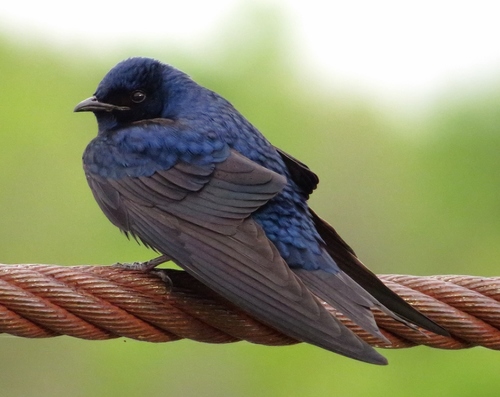
Purple Martin
The Purple Martin (Progne subis) is the largest swallow in North America, renowned for its aerial agility and almost exclusive reliance on human-provided nesting structures in the eastern part of its range. These birds play a vital ecological role as insectivores, consuming vast quantities of flying insects. Culturally, Purple Martins have a long and unique relationship with humans, dating back to Native Americans who hung hollowed-out gourds for them to nest in. This close association continues today, with many people actively managing Martin colonies.
17-20 cm
Length
38-42 cm
Wingspan
Least Concern
Conservation Status
Distribution
Breeds across much of North America, from central Alberta east to Nova Scotia, and south to Florida and parts of Mexico. Winters in South America, primarily in the Amazon basin. Migrates through Central America and the Caribbean.
Lifespan
Up to 7-8 years in the wild, though the average is likely lower. Records of up to 11 years exist.
Purple Martin's Habitat
Habitat Types
Open woodlands, Savannas, Agricultural areas, Urban and suburban areas (particularly near water)
Climate Zones
Temperate, Subtropical, Tropical (during winter)
Adaptations
Highly adapted for aerial foraging, with long, pointed wings and a streamlined body. Their dependence on open habitats reflects their need for unobstructed flight paths while hunting insects.
Variations
Three subspecies are generally recognized: *P. s. subis* (eastern North America), *P. s. hesperia* (southwestern US and northwestern Mexico), and *P. s. arboricola* (western North America). These differ slightly in size and plumage coloration.
Appearance
Breeding Plumage
Adult males are entirely glossy, iridescent blue-black. Females and immature birds are duller, with grayish-brown upperparts and lighter underparts. Nonbreeding plumage is similar to breeding plumage.
Seasonal Feather Changes
Minimal seasonal variation, primarily related to feather wear.
Sex Based Plumage Differences
Significant. Adult males are easily distinguished from females and immatures by their dark, iridescent plumage.
Notable Features
Long, pointed wings, Slightly forked tail, Broad, flat bill
Diet and Feeding
Primary Foods
Flying insects (e.g., dragonflies, flies, beetles, moths, wasps, bees)
Foraging Behavior
Forages almost exclusively in flight, catching insects on the wing. Often forages at higher altitudes than other swallows, sometimes above 50 meters.
Specializations
Agile flight allows for capturing a wide variety of insects. They also drink and bathe in flight, skimming the surface of water bodies.
Seasonal Diet Variations
Diet composition varies depending on the availability of insects throughout the year and across their range. May consume some small fruits on rare occasions.
Behavior
Social Structure
Highly colonial, especially during the breeding season. Forms large flocks during migration and on wintering grounds.
Communication
Rich repertoire of vocalizations, including chortles, rattles, and croaks, Aerial displays used in courtship and territorial defense
Migration
Long-distance migrant, traveling between breeding grounds in North America and wintering grounds in South America. Migrates in large flocks, often following coastlines and river valleys.
Territorial or Group Behaviors
Males defend their nesting compartments vigorously against other males. Colonies can consist of dozens or even hundreds of pairs.
Conservation
Threats
Loss of nesting sites (particularly in the western part of the range due to competition with invasive species like European Starlings and House Sparrows), Pesticide use (reducing insect prey), Climate change (affecting insect emergence and migration timing)
Protection Programs
Provision of artificial nesting structures, Public education about the importance of Purple Martins and their conservation, Monitoring of populations and nesting success
Local National Laws
Protected under the Migratory Bird Treaty Act in the United States and Canada.
Population Trend
Stable or slightly increasing overall, but with regional declines in some areas.
Population Estimates
Global population estimated at around 6-10 million individuals.
Interesting Facts
Purple Martins are almost entirely dependent on human-provided housing in the eastern US.
This unique relationship began with Native Americans, who hung hollowed-out gourds for the birds to nest in.
They are known for their "dawn song."
Males sing a complex song before sunrise, thought to attract other martins to the colony.
They are incredibly loyal to their nesting sites.
Purple Martins often return to the same nesting site, and even the same compartment, year after year.
They can consume large numbers of mosquitoes.
While mosquitoes are not their primary food source, Purple Martins do eat them, along with many other flying insects.
Faqs about Purple Martin
How can I attract Purple Martins to my yard?
Provide suitable housing (multi-compartment birdhouses or gourds) in an open area, away from trees. Keep the housing clean and free of competitors like House Sparrows and European Starlings.
When do Purple Martins migrate?
They typically arrive in the southern US in late January or February and gradually move north, reaching Canada by May. They begin their southward migration in late summer and early fall.
What do Purple Martins eat?
They eat flying insects, including dragonflies, flies, beetles, moths, and wasps. They catch their prey in flight.
Do Purple Martins mate for life?
While they are socially monogamous during a single breeding season, they do not necessarily mate for life and may choose different partners in subsequent years.
Copyright @ Nature Style Limited. All Rights Reserved.
 English
English